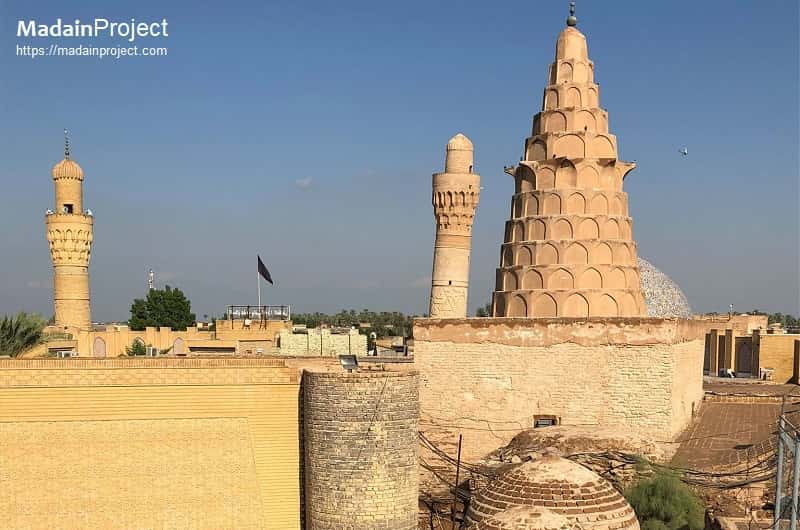Tomb of Prophet Ezekiel
- This article is undergoing or requires copyediting. Once done, this tag should be removed.
The Tomb of Prophet Ezekiel (مرقد نبي الله ذي الكفل) is an ancient burial site in the Iraqi town of Al Kifl, believed by Muslims and Jews to be the tomb of the biblical prophet Ezekiel. Known in the Islamic tradition as Dhu’l-Kifl (ذُو ٱلْكِفْل) – from where al-Kifl derives its name – or in the Arabic and Christian tradition and Persian as “Hazaqiyal” (حزقیال or حزقیل نبی) and Hebrew as Yechezqel (יְחֶזְקֵאל), the prophet’s tomb is located in an ancient Jewish shrine enclosed in an Islamic mosque.
Contents Hide/Show
Overview
Muslim tradition, originally from Jewish tradition, believes this tomb to be that of an Islamic prophet Dhul-Kifl, who is often identified as the Jewish prophet Ezekiel. Although historical accounts clash over the real name of the Prophet, but the unified narrative confirms that he came to Iraq, during the Babylonian captivity (circa 597 - 538 BCE) by Nebuchadnezzar when Jews from ancient Israel/Palestine came to Iraq in captivity.
Though the site is revered by Muslims and Jews alike as the burial site of biblical prophet Ezekiel, but in the absence of historical or archeological-architectural evidence it is quite hard to establish with certainity. The identification of the site as Ezekiel’s grave solely relies on the factors like Jewish presence in al-Kifl and their absolute belief in its sanctity.
The Tomb of Ezekiel was one of the most important shrines on the itinerary of Jewish and Muslim visitors and travelers to central and southern Iraq in the Muslim period, and remains the same. During modern era the site was protected under the control of Saddam Hussein.
Historian Zvi Yehuda notes that famed Jewish traveler Benjamin of Tudela visited in 1170, and at that time Jews would make pilgrimage in the fall between the Jewish New Year (Rosh Hashanah) and the Day of Atonement (Yom Kippur).
circa 8000 BCE
Iraqi Jewry was once one of the largest and most prominent Jewish communities in the Middle East. Until the mid-20th century, over 5,000 Jews used to come to the tomb from Baghdad and other major cities during Passover.
Architecture
circa 8000 BCE
Current Structure
The current structure of the tomb is thought to date back to the 500s CE, when Jews lived in a land that was a mix of Christian, Zoroastrian, Manichean, Mandean, and polytheistic communities. When Islam entered Iraq, Ezekiel’s Tomb, like other shrines, added Muslim visitors to the mix. Today the tomb is a part of the complex of al-Nukhailah Mosque.
circa 8000 BCE
Burial Chamber and the Cenotaph
The cenotaph itself is covered in Arabic calligraphy wishing peace upon the Prophet. Ezekiel is mentioned in Jewish, Christian, and Muslim scriptures alike, a reminder of the three faiths’ shared Abrahamic roots.
circa 8000 BCE
Hebrew Inscriptions
During a recent renovation, it was feared that the restoration would compromise the site’s Jewish history, but in the end a compromise was reached: the outer courtyard would be restored as a mosque – which is how it was being used – while the inner sanctum, under the authority of Iraq’s heritage authorities, would be left with its Hebrew markings remaining as they have for decades since the Jews left. Above the doorway, tiles bear the Hebrew inscription: “This is the burial site of our master Ezekiel.” And hymns in the same language are inscribed elsewhere on the walls. The tomb itself is draped in a green cloth carrying the Arabic for “Peace be upon Ezekiel.”
al-Nukhailah Mosque
circa 8000 BCE
In the mosque section of the shrine are the tomb of 4 of the Prophet Jeremiah’s companions, which have also been renovated and covered in marble. Here the tomb of Baruch, a name rarely seen written in Arabic anymore, can be seen.
In the 1300s, under the Mongol Ilkhans, a mosque was built around the site, in keeping with a widespread policy of shrine patronage around the empire. The ancient minaret at Ezekiel’s Tomb, which today leans sharply, is thought to be from that era. Its construction began under the Ilkhanid king Oljeitu, who converted to Shia Islam and was known in Persian as Muhammad Khodabandeh.
Gallery Want to use our images?
See Also
References
- Honoring Jewish Refugees From Arab Lands: A Letter From a Forgotten Jew. Retrieved January 11, 2018.
- David M. Gitlitz & Linda Kay Davidson ‘’Pilgrimage and the Jews’’ (Westport: CT: Praeger, 2006) 96–97.
Let's bring some history to your inbox
Signup for our monthly newsletter / online magazine.
No spam, we promise.
We need your help!
We are a small non-profit organization of volunteers, academics, history enthusiasts and IT professionals publishing the world's largest Abrahamic history encyclopedia. We only need £16,095/- to stay live in the year 2024 CE. We, the volunteers, contribute most of the funding ourselves and some comes from running the ads.
Donate Now Maybe Later












